Service Industry Leadership: Styles, Structures, and Factors
VerifiedAdded on 2023/06/18
|26
|10081
|260
Report
AI Summary
This report provides a detailed analysis of leadership and management styles within the service industry, drawing on classical management theories and exploring their practical application in specific service sector organizations like ABC and EFG hotels. It examines the roles of leaders, different leadership styles such as Laissez-Faire, Autocratic, and Democratic, and the factors that influence management styles and organizational structures. The report also assesses current and future management skills required for the service sector, discussing how these skills can be achieved and evaluating their importance. Furthermore, it compares and contrasts change management systems and leadership approaches across different service industry organizations, highlighting the importance of adapting management strategies to the specific context of each organization.
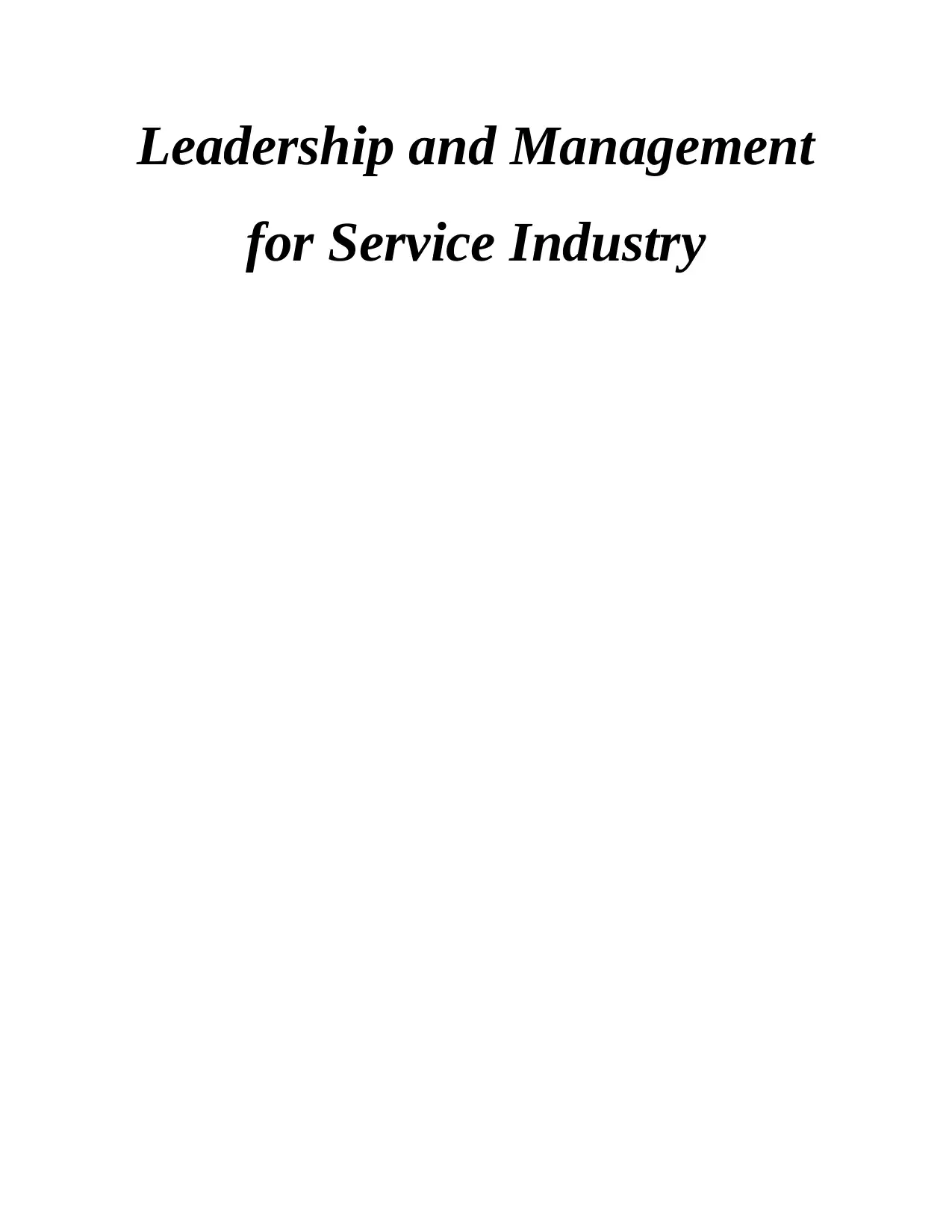
Leadership and Management
for Service Industry
for Service Industry
Paraphrase This Document
Need a fresh take? Get an instant paraphrase of this document with our AI Paraphraser

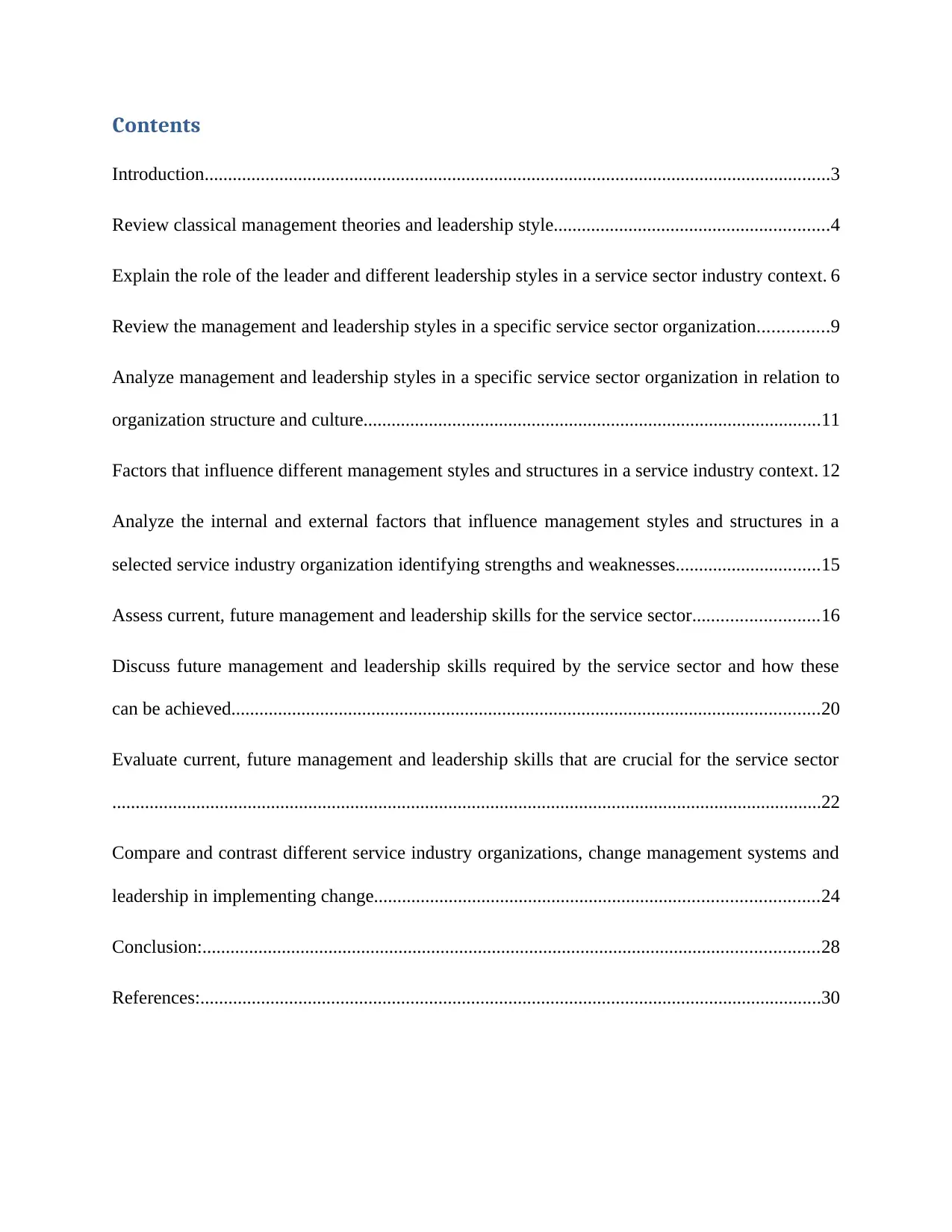
Contents
Introduction......................................................................................................................................3
Review classical management theories and leadership style...........................................................4
Explain the role of the leader and different leadership styles in a service sector industry context. 6
Review the management and leadership styles in a specific service sector organization...............9
Analyze management and leadership styles in a specific service sector organization in relation to
organization structure and culture..................................................................................................11
Factors that influence different management styles and structures in a service industry context. 12
Analyze the internal and external factors that influence management styles and structures in a
selected service industry organization identifying strengths and weaknesses...............................15
Assess current, future management and leadership skills for the service sector...........................16
Discuss future management and leadership skills required by the service sector and how these
can be achieved..............................................................................................................................20
Evaluate current, future management and leadership skills that are crucial for the service sector
........................................................................................................................................................22
Compare and contrast different service industry organizations, change management systems and
leadership in implementing change...............................................................................................24
Conclusion:....................................................................................................................................28
References:.....................................................................................................................................30
Introduction......................................................................................................................................3
Review classical management theories and leadership style...........................................................4
Explain the role of the leader and different leadership styles in a service sector industry context. 6
Review the management and leadership styles in a specific service sector organization...............9
Analyze management and leadership styles in a specific service sector organization in relation to
organization structure and culture..................................................................................................11
Factors that influence different management styles and structures in a service industry context. 12
Analyze the internal and external factors that influence management styles and structures in a
selected service industry organization identifying strengths and weaknesses...............................15
Assess current, future management and leadership skills for the service sector...........................16
Discuss future management and leadership skills required by the service sector and how these
can be achieved..............................................................................................................................20
Evaluate current, future management and leadership skills that are crucial for the service sector
........................................................................................................................................................22
Compare and contrast different service industry organizations, change management systems and
leadership in implementing change...............................................................................................24
Conclusion:....................................................................................................................................28
References:.....................................................................................................................................30
⊘ This is a preview!⊘
Do you want full access?
Subscribe today to unlock all pages.

Trusted by 1+ million students worldwide
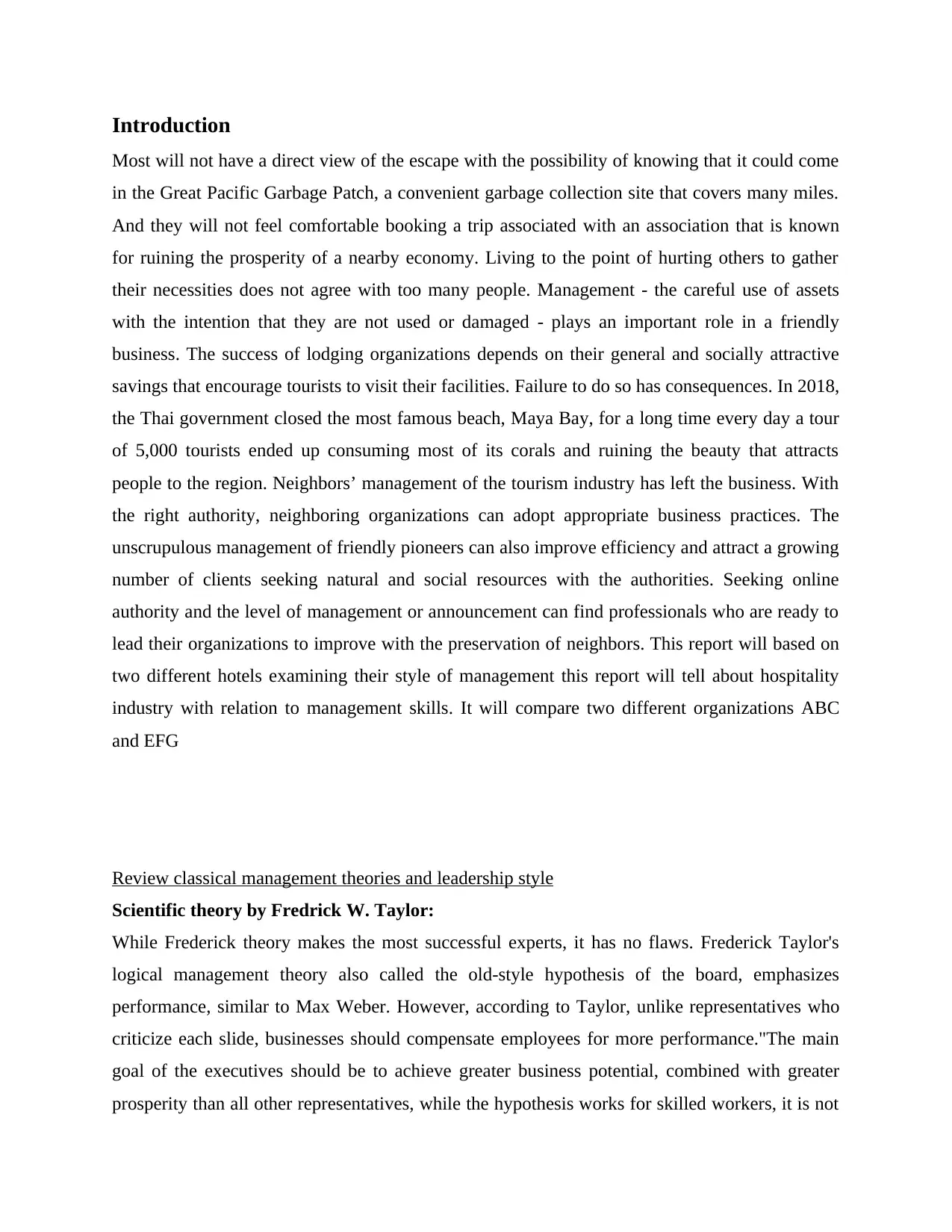
Introduction
Most will not have a direct view of the escape with the possibility of knowing that it could come
in the Great Pacific Garbage Patch, a convenient garbage collection site that covers many miles.
And they will not feel comfortable booking a trip associated with an association that is known
for ruining the prosperity of a nearby economy. Living to the point of hurting others to gather
their necessities does not agree with too many people. Management - the careful use of assets
with the intention that they are not used or damaged - plays an important role in a friendly
business. The success of lodging organizations depends on their general and socially attractive
savings that encourage tourists to visit their facilities. Failure to do so has consequences. In 2018,
the Thai government closed the most famous beach, Maya Bay, for a long time every day a tour
of 5,000 tourists ended up consuming most of its corals and ruining the beauty that attracts
people to the region. Neighbors’ management of the tourism industry has left the business. With
the right authority, neighboring organizations can adopt appropriate business practices. The
unscrupulous management of friendly pioneers can also improve efficiency and attract a growing
number of clients seeking natural and social resources with the authorities. Seeking online
authority and the level of management or announcement can find professionals who are ready to
lead their organizations to improve with the preservation of neighbors. This report will based on
two different hotels examining their style of management this report will tell about hospitality
industry with relation to management skills. It will compare two different organizations ABC
and EFG
Review classical management theories and leadership style
Scientific theory by Fredrick W. Taylor:
While Frederick theory makes the most successful experts, it has no flaws. Frederick Taylor's
logical management theory also called the old-style hypothesis of the board, emphasizes
performance, similar to Max Weber. However, according to Taylor, unlike representatives who
criticize each slide, businesses should compensate employees for more performance."The main
goal of the executives should be to achieve greater business potential, combined with greater
prosperity than all other representatives, while the hypothesis works for skilled workers, it is not
Most will not have a direct view of the escape with the possibility of knowing that it could come
in the Great Pacific Garbage Patch, a convenient garbage collection site that covers many miles.
And they will not feel comfortable booking a trip associated with an association that is known
for ruining the prosperity of a nearby economy. Living to the point of hurting others to gather
their necessities does not agree with too many people. Management - the careful use of assets
with the intention that they are not used or damaged - plays an important role in a friendly
business. The success of lodging organizations depends on their general and socially attractive
savings that encourage tourists to visit their facilities. Failure to do so has consequences. In 2018,
the Thai government closed the most famous beach, Maya Bay, for a long time every day a tour
of 5,000 tourists ended up consuming most of its corals and ruining the beauty that attracts
people to the region. Neighbors’ management of the tourism industry has left the business. With
the right authority, neighboring organizations can adopt appropriate business practices. The
unscrupulous management of friendly pioneers can also improve efficiency and attract a growing
number of clients seeking natural and social resources with the authorities. Seeking online
authority and the level of management or announcement can find professionals who are ready to
lead their organizations to improve with the preservation of neighbors. This report will based on
two different hotels examining their style of management this report will tell about hospitality
industry with relation to management skills. It will compare two different organizations ABC
and EFG
Review classical management theories and leadership style
Scientific theory by Fredrick W. Taylor:
While Frederick theory makes the most successful experts, it has no flaws. Frederick Taylor's
logical management theory also called the old-style hypothesis of the board, emphasizes
performance, similar to Max Weber. However, according to Taylor, unlike representatives who
criticize each slide, businesses should compensate employees for more performance."The main
goal of the executives should be to achieve greater business potential, combined with greater
prosperity than all other representatives, while the hypothesis works for skilled workers, it is not
Paraphrase This Document
Need a fresh take? Get an instant paraphrase of this document with our AI Paraphraser
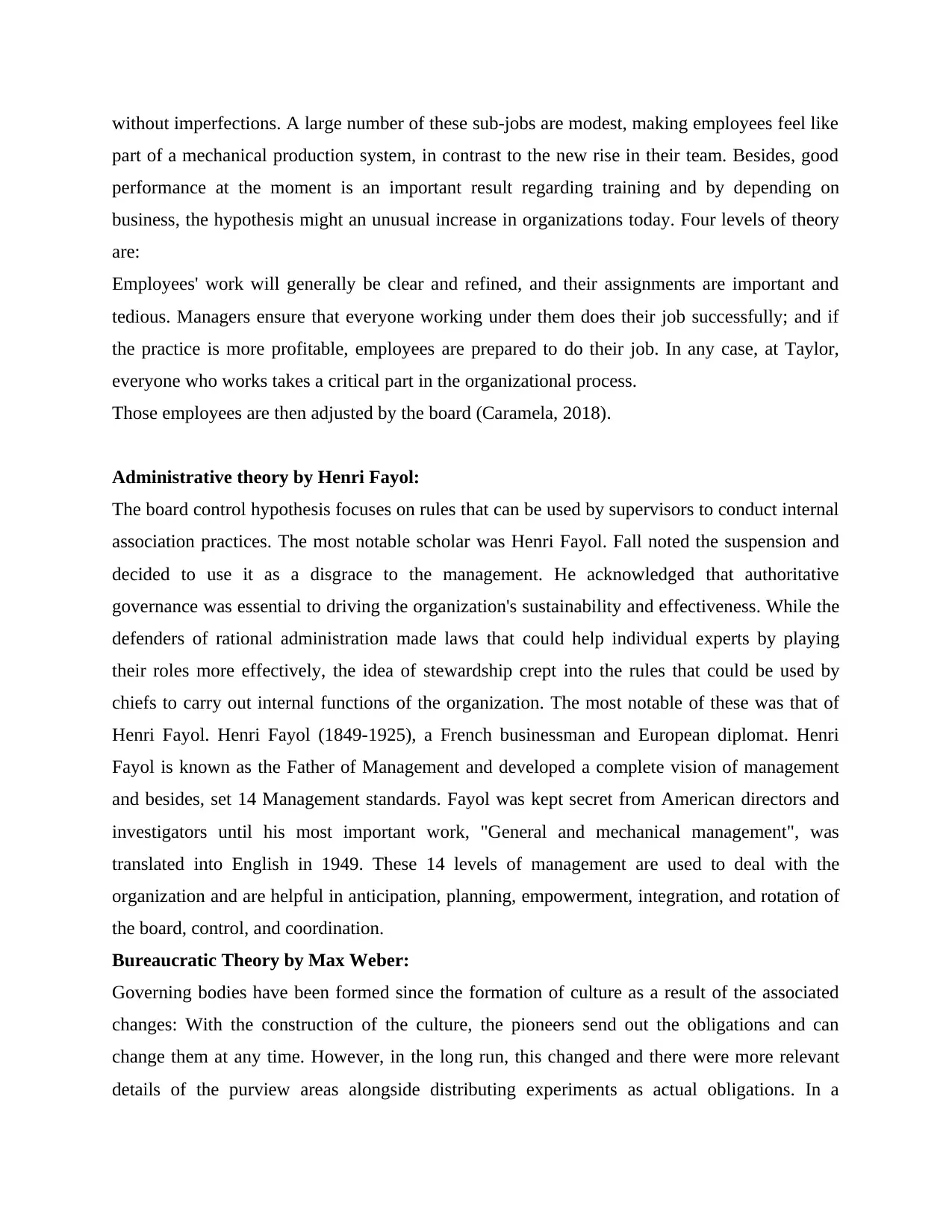
without imperfections. A large number of these sub-jobs are modest, making employees feel like
part of a mechanical production system, in contrast to the new rise in their team. Besides, good
performance at the moment is an important result regarding training and by depending on
business, the hypothesis might an unusual increase in organizations today. Four levels of theory
are:
Employees' work will generally be clear and refined, and their assignments are important and
tedious. Managers ensure that everyone working under them does their job successfully; and if
the practice is more profitable, employees are prepared to do their job. In any case, at Taylor,
everyone who works takes a critical part in the organizational process.
Those employees are then adjusted by the board (Caramela, 2018).
Administrative theory by Henri Fayol:
The board control hypothesis focuses on rules that can be used by supervisors to conduct internal
association practices. The most notable scholar was Henri Fayol. Fall noted the suspension and
decided to use it as a disgrace to the management. He acknowledged that authoritative
governance was essential to driving the organization's sustainability and effectiveness. While the
defenders of rational administration made laws that could help individual experts by playing
their roles more effectively, the idea of stewardship crept into the rules that could be used by
chiefs to carry out internal functions of the organization. The most notable of these was that of
Henri Fayol. Henri Fayol (1849-1925), a French businessman and European diplomat. Henri
Fayol is known as the Father of Management and developed a complete vision of management
and besides, set 14 Management standards. Fayol was kept secret from American directors and
investigators until his most important work, "General and mechanical management", was
translated into English in 1949. These 14 levels of management are used to deal with the
organization and are helpful in anticipation, planning, empowerment, integration, and rotation of
the board, control, and coordination.
Bureaucratic Theory by Max Weber:
Governing bodies have been formed since the formation of culture as a result of the associated
changes: With the construction of the culture, the pioneers send out the obligations and can
change them at any time. However, in the long run, this changed and there were more relevant
details of the purview areas alongside distributing experiments as actual obligations. In a
part of a mechanical production system, in contrast to the new rise in their team. Besides, good
performance at the moment is an important result regarding training and by depending on
business, the hypothesis might an unusual increase in organizations today. Four levels of theory
are:
Employees' work will generally be clear and refined, and their assignments are important and
tedious. Managers ensure that everyone working under them does their job successfully; and if
the practice is more profitable, employees are prepared to do their job. In any case, at Taylor,
everyone who works takes a critical part in the organizational process.
Those employees are then adjusted by the board (Caramela, 2018).
Administrative theory by Henri Fayol:
The board control hypothesis focuses on rules that can be used by supervisors to conduct internal
association practices. The most notable scholar was Henri Fayol. Fall noted the suspension and
decided to use it as a disgrace to the management. He acknowledged that authoritative
governance was essential to driving the organization's sustainability and effectiveness. While the
defenders of rational administration made laws that could help individual experts by playing
their roles more effectively, the idea of stewardship crept into the rules that could be used by
chiefs to carry out internal functions of the organization. The most notable of these was that of
Henri Fayol. Henri Fayol (1849-1925), a French businessman and European diplomat. Henri
Fayol is known as the Father of Management and developed a complete vision of management
and besides, set 14 Management standards. Fayol was kept secret from American directors and
investigators until his most important work, "General and mechanical management", was
translated into English in 1949. These 14 levels of management are used to deal with the
organization and are helpful in anticipation, planning, empowerment, integration, and rotation of
the board, control, and coordination.
Bureaucratic Theory by Max Weber:
Governing bodies have been formed since the formation of culture as a result of the associated
changes: With the construction of the culture, the pioneers send out the obligations and can
change them at any time. However, in the long run, this changed and there were more relevant
details of the purview areas alongside distributing experiments as actual obligations. In a
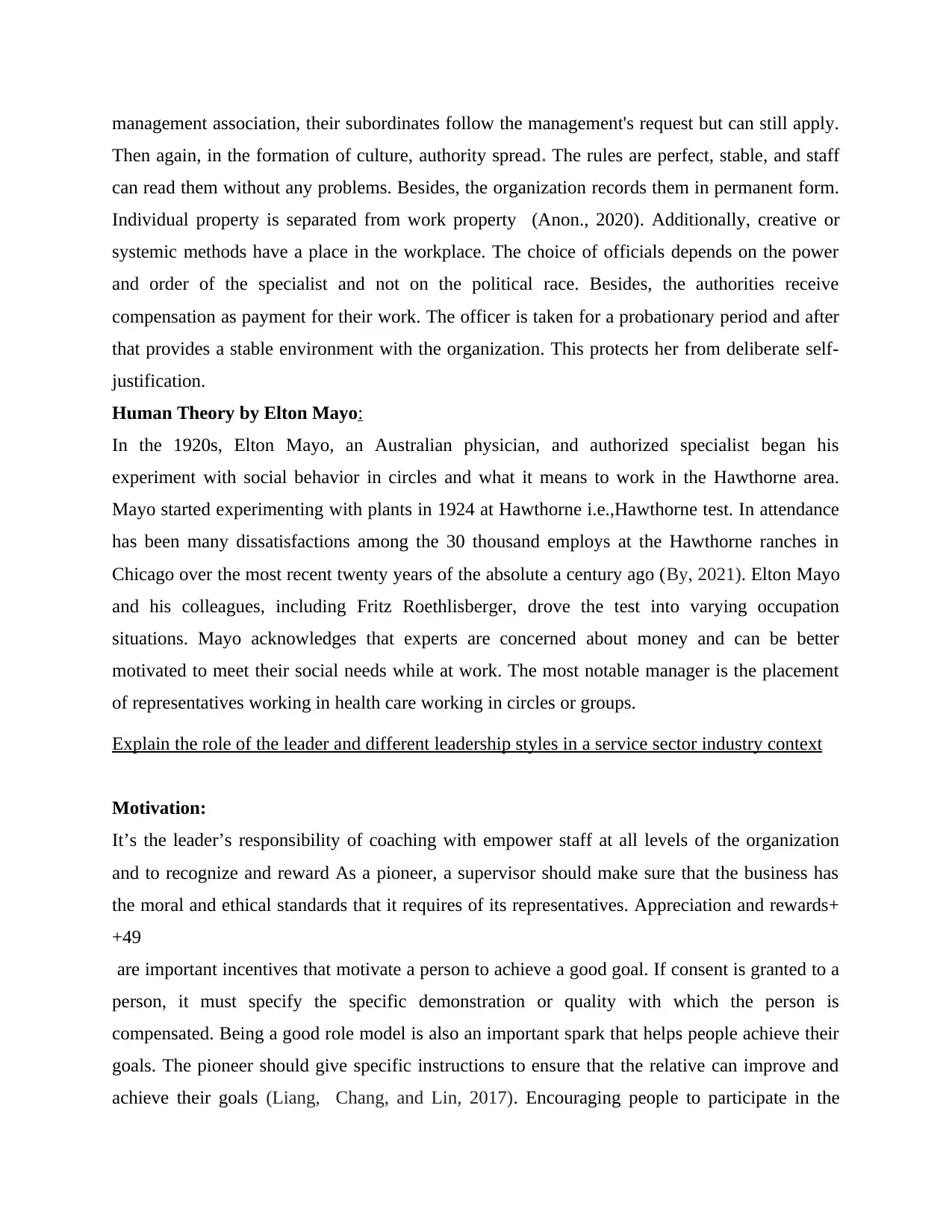
management association, their subordinates follow the management's request but can still apply.
Then again, in the formation of culture, authority spread. The rules are perfect, stable, and staff
can read them without any problems. Besides, the organization records them in permanent form.
Individual property is separated from work property (Anon., 2020). Additionally, creative or
systemic methods have a place in the workplace. The choice of officials depends on the power
and order of the specialist and not on the political race. Besides, the authorities receive
compensation as payment for their work. The officer is taken for a probationary period and after
that provides a stable environment with the organization. This protects her from deliberate self-
justification.
Human Theory by Elton Mayo:
In the 1920s, Elton Mayo, an Australian physician, and authorized specialist began his
experiment with social behavior in circles and what it means to work in the Hawthorne area.
Mayo started experimenting with plants in 1924 at Hawthorne i.e.,Hawthorne test. In attendance
has been many dissatisfactions among the 30 thousand employs at the Hawthorne ranches in
Chicago over the most recent twenty years of the absolute a century ago (By, 2021). Elton Mayo
and his colleagues, including Fritz Roethlisberger, drove the test into varying occupation
situations. Mayo acknowledges that experts are concerned about money and can be better
motivated to meet their social needs while at work. The most notable manager is the placement
of representatives working in health care working in circles or groups.
Explain the role of the leader and different leadership styles in a service sector industry context
Motivation:
It’s the leader’s responsibility of coaching with empower staff at all levels of the organization
and to recognize and reward As a pioneer, a supervisor should make sure that the business has
the moral and ethical standards that it requires of its representatives. Appreciation and rewards+
+49
are important incentives that motivate a person to achieve a good goal. If consent is granted to a
person, it must specify the specific demonstration or quality with which the person is
compensated. Being a good role model is also an important spark that helps people achieve their
goals. The pioneer should give specific instructions to ensure that the relative can improve and
achieve their goals (Liang, Chang, and Lin, 2017). Encouraging people to participate in the
Then again, in the formation of culture, authority spread. The rules are perfect, stable, and staff
can read them without any problems. Besides, the organization records them in permanent form.
Individual property is separated from work property (Anon., 2020). Additionally, creative or
systemic methods have a place in the workplace. The choice of officials depends on the power
and order of the specialist and not on the political race. Besides, the authorities receive
compensation as payment for their work. The officer is taken for a probationary period and after
that provides a stable environment with the organization. This protects her from deliberate self-
justification.
Human Theory by Elton Mayo:
In the 1920s, Elton Mayo, an Australian physician, and authorized specialist began his
experiment with social behavior in circles and what it means to work in the Hawthorne area.
Mayo started experimenting with plants in 1924 at Hawthorne i.e.,Hawthorne test. In attendance
has been many dissatisfactions among the 30 thousand employs at the Hawthorne ranches in
Chicago over the most recent twenty years of the absolute a century ago (By, 2021). Elton Mayo
and his colleagues, including Fritz Roethlisberger, drove the test into varying occupation
situations. Mayo acknowledges that experts are concerned about money and can be better
motivated to meet their social needs while at work. The most notable manager is the placement
of representatives working in health care working in circles or groups.
Explain the role of the leader and different leadership styles in a service sector industry context
Motivation:
It’s the leader’s responsibility of coaching with empower staff at all levels of the organization
and to recognize and reward As a pioneer, a supervisor should make sure that the business has
the moral and ethical standards that it requires of its representatives. Appreciation and rewards+
+49
are important incentives that motivate a person to achieve a good goal. If consent is granted to a
person, it must specify the specific demonstration or quality with which the person is
compensated. Being a good role model is also an important spark that helps people achieve their
goals. The pioneer should give specific instructions to ensure that the relative can improve and
achieve their goals (Liang, Chang, and Lin, 2017). Encouraging people to participate in the
⊘ This is a preview!⊘
Do you want full access?
Subscribe today to unlock all pages.

Trusted by 1+ million students worldwide
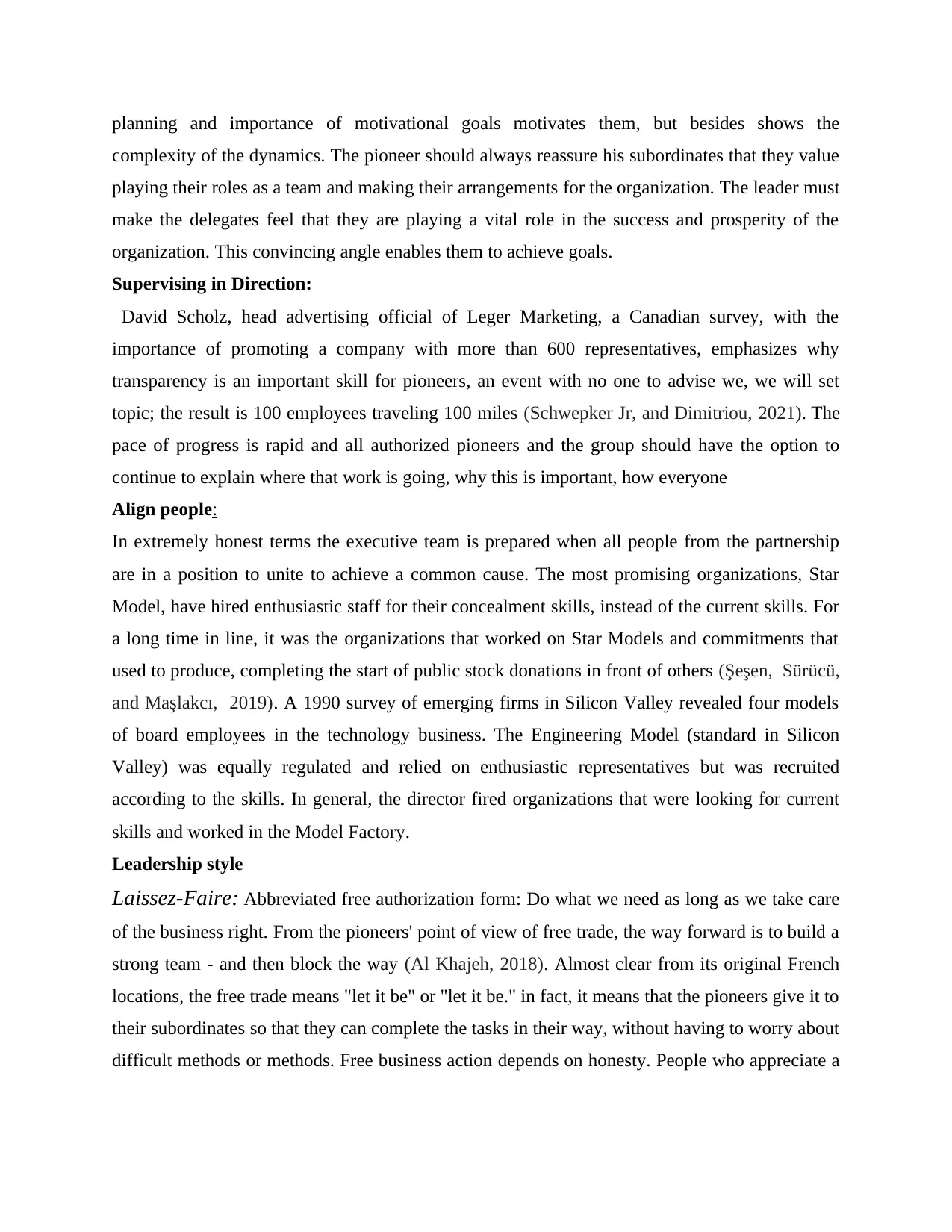
planning and importance of motivational goals motivates them, but besides shows the
complexity of the dynamics. The pioneer should always reassure his subordinates that they value
playing their roles as a team and making their arrangements for the organization. The leader must
make the delegates feel that they are playing a vital role in the success and prosperity of the
organization. This convincing angle enables them to achieve goals.
Supervising in Direction:
David Scholz, head advertising official of Leger Marketing, a Canadian survey, with the
importance of promoting a company with more than 600 representatives, emphasizes why
transparency is an important skill for pioneers, an event with no one to advise we, we will set
topic; the result is 100 employees traveling 100 miles (Schwepker Jr, and Dimitriou, 2021). The
pace of progress is rapid and all authorized pioneers and the group should have the option to
continue to explain where that work is going, why this is important, how everyone
Align people:
In extremely honest terms the executive team is prepared when all people from the partnership
are in a position to unite to achieve a common cause. The most promising organizations, Star
Model, have hired enthusiastic staff for their concealment skills, instead of the current skills. For
a long time in line, it was the organizations that worked on Star Models and commitments that
used to produce, completing the start of public stock donations in front of others (Şeşen, Sürücü,
and Maşlakcı, 2019). A 1990 survey of emerging firms in Silicon Valley revealed four models
of board employees in the technology business. The Engineering Model (standard in Silicon
Valley) was equally regulated and relied on enthusiastic representatives but was recruited
according to the skills. In general, the director fired organizations that were looking for current
skills and worked in the Model Factory.
Leadership style
Laissez-Faire: Abbreviated free authorization form: Do what we need as long as we take care
of the business right. From the pioneers' point of view of free trade, the way forward is to build a
strong team - and then block the way (Al Khajeh, 2018). Almost clear from its original French
locations, the free trade means "let it be" or "let it be." in fact, it means that the pioneers give it to
their subordinates so that they can complete the tasks in their way, without having to worry about
difficult methods or methods. Free business action depends on honesty. People who appreciate a
complexity of the dynamics. The pioneer should always reassure his subordinates that they value
playing their roles as a team and making their arrangements for the organization. The leader must
make the delegates feel that they are playing a vital role in the success and prosperity of the
organization. This convincing angle enables them to achieve goals.
Supervising in Direction:
David Scholz, head advertising official of Leger Marketing, a Canadian survey, with the
importance of promoting a company with more than 600 representatives, emphasizes why
transparency is an important skill for pioneers, an event with no one to advise we, we will set
topic; the result is 100 employees traveling 100 miles (Schwepker Jr, and Dimitriou, 2021). The
pace of progress is rapid and all authorized pioneers and the group should have the option to
continue to explain where that work is going, why this is important, how everyone
Align people:
In extremely honest terms the executive team is prepared when all people from the partnership
are in a position to unite to achieve a common cause. The most promising organizations, Star
Model, have hired enthusiastic staff for their concealment skills, instead of the current skills. For
a long time in line, it was the organizations that worked on Star Models and commitments that
used to produce, completing the start of public stock donations in front of others (Şeşen, Sürücü,
and Maşlakcı, 2019). A 1990 survey of emerging firms in Silicon Valley revealed four models
of board employees in the technology business. The Engineering Model (standard in Silicon
Valley) was equally regulated and relied on enthusiastic representatives but was recruited
according to the skills. In general, the director fired organizations that were looking for current
skills and worked in the Model Factory.
Leadership style
Laissez-Faire: Abbreviated free authorization form: Do what we need as long as we take care
of the business right. From the pioneers' point of view of free trade, the way forward is to build a
strong team - and then block the way (Al Khajeh, 2018). Almost clear from its original French
locations, the free trade means "let it be" or "let it be." in fact, it means that the pioneers give it to
their subordinates so that they can complete the tasks in their way, without having to worry about
difficult methods or methods. Free business action depends on honesty. People who appreciate a
Paraphrase This Document
Need a fresh take? Get an instant paraphrase of this document with our AI Paraphraser
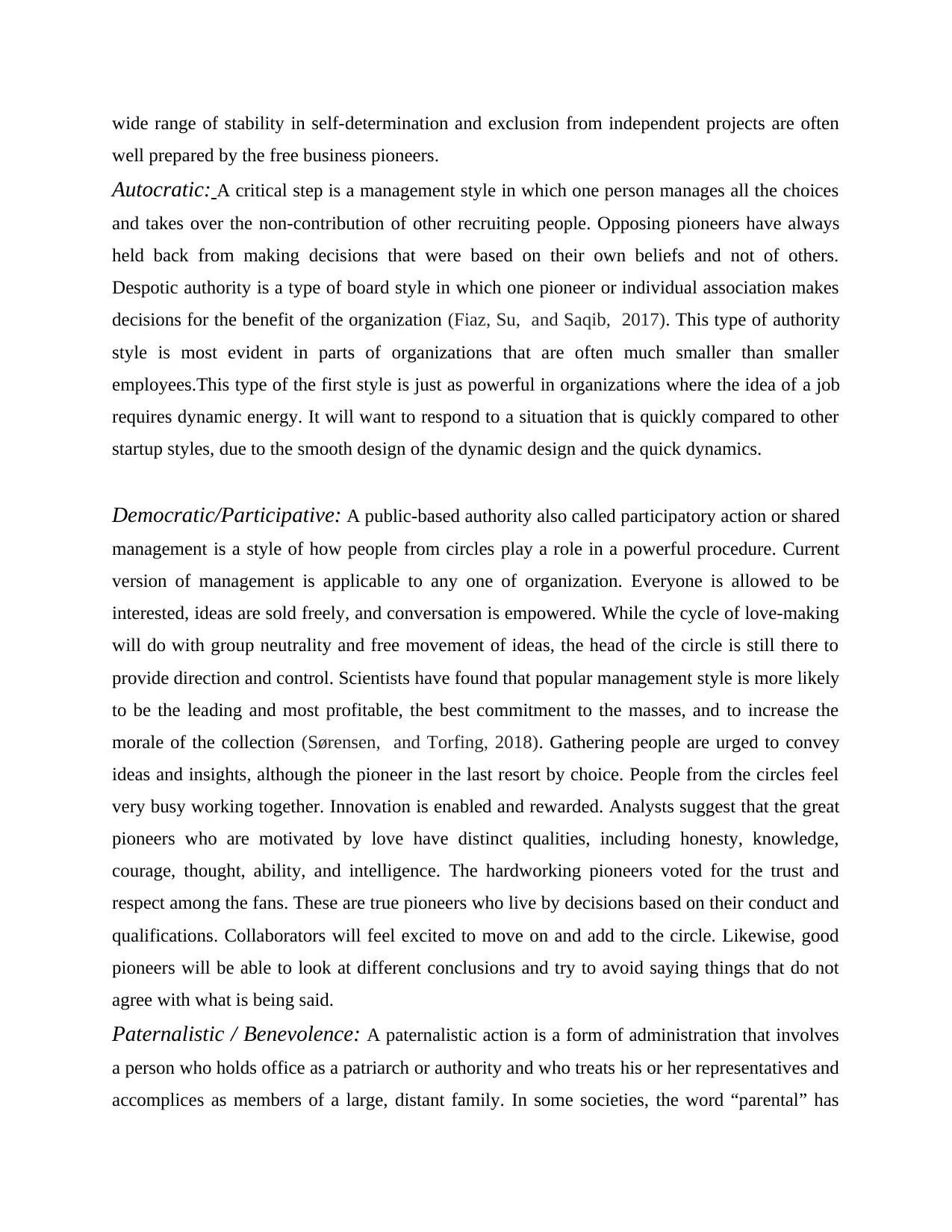
wide range of stability in self-determination and exclusion from independent projects are often
well prepared by the free business pioneers.
Autocratic: A critical step is a management style in which one person manages all the choices
and takes over the non-contribution of other recruiting people. Opposing pioneers have always
held back from making decisions that were based on their own beliefs and not of others.
Despotic authority is a type of board style in which one pioneer or individual association makes
decisions for the benefit of the organization (Fiaz, Su, and Saqib, 2017). This type of authority
style is most evident in parts of organizations that are often much smaller than smaller
employees.This type of the first style is just as powerful in organizations where the idea of a job
requires dynamic energy. It will want to respond to a situation that is quickly compared to other
startup styles, due to the smooth design of the dynamic design and the quick dynamics.
Democratic/Participative: A public-based authority also called participatory action or shared
management is a style of how people from circles play a role in a powerful procedure. Current
version of management is applicable to any one of organization. Everyone is allowed to be
interested, ideas are sold freely, and conversation is empowered. While the cycle of love-making
will do with group neutrality and free movement of ideas, the head of the circle is still there to
provide direction and control. Scientists have found that popular management style is more likely
to be the leading and most profitable, the best commitment to the masses, and to increase the
morale of the collection (Sørensen, and Torfing, 2018). Gathering people are urged to convey
ideas and insights, although the pioneer in the last resort by choice. People from the circles feel
very busy working together. Innovation is enabled and rewarded. Analysts suggest that the great
pioneers who are motivated by love have distinct qualities, including honesty, knowledge,
courage, thought, ability, and intelligence. The hardworking pioneers voted for the trust and
respect among the fans. These are true pioneers who live by decisions based on their conduct and
qualifications. Collaborators will feel excited to move on and add to the circle. Likewise, good
pioneers will be able to look at different conclusions and try to avoid saying things that do not
agree with what is being said.
Paternalistic / Benevolence: A paternalistic action is a form of administration that involves
a person who holds office as a patriarch or authority and who treats his or her representatives and
accomplices as members of a large, distant family. In some societies, the word “parental” has
well prepared by the free business pioneers.
Autocratic: A critical step is a management style in which one person manages all the choices
and takes over the non-contribution of other recruiting people. Opposing pioneers have always
held back from making decisions that were based on their own beliefs and not of others.
Despotic authority is a type of board style in which one pioneer or individual association makes
decisions for the benefit of the organization (Fiaz, Su, and Saqib, 2017). This type of authority
style is most evident in parts of organizations that are often much smaller than smaller
employees.This type of the first style is just as powerful in organizations where the idea of a job
requires dynamic energy. It will want to respond to a situation that is quickly compared to other
startup styles, due to the smooth design of the dynamic design and the quick dynamics.
Democratic/Participative: A public-based authority also called participatory action or shared
management is a style of how people from circles play a role in a powerful procedure. Current
version of management is applicable to any one of organization. Everyone is allowed to be
interested, ideas are sold freely, and conversation is empowered. While the cycle of love-making
will do with group neutrality and free movement of ideas, the head of the circle is still there to
provide direction and control. Scientists have found that popular management style is more likely
to be the leading and most profitable, the best commitment to the masses, and to increase the
morale of the collection (Sørensen, and Torfing, 2018). Gathering people are urged to convey
ideas and insights, although the pioneer in the last resort by choice. People from the circles feel
very busy working together. Innovation is enabled and rewarded. Analysts suggest that the great
pioneers who are motivated by love have distinct qualities, including honesty, knowledge,
courage, thought, ability, and intelligence. The hardworking pioneers voted for the trust and
respect among the fans. These are true pioneers who live by decisions based on their conduct and
qualifications. Collaborators will feel excited to move on and add to the circle. Likewise, good
pioneers will be able to look at different conclusions and try to avoid saying things that do not
agree with what is being said.
Paternalistic / Benevolence: A paternalistic action is a form of administration that involves
a person who holds office as a patriarch or authority and who treats his or her representatives and
accomplices as members of a large, distant family. In some societies, the word “parental” has
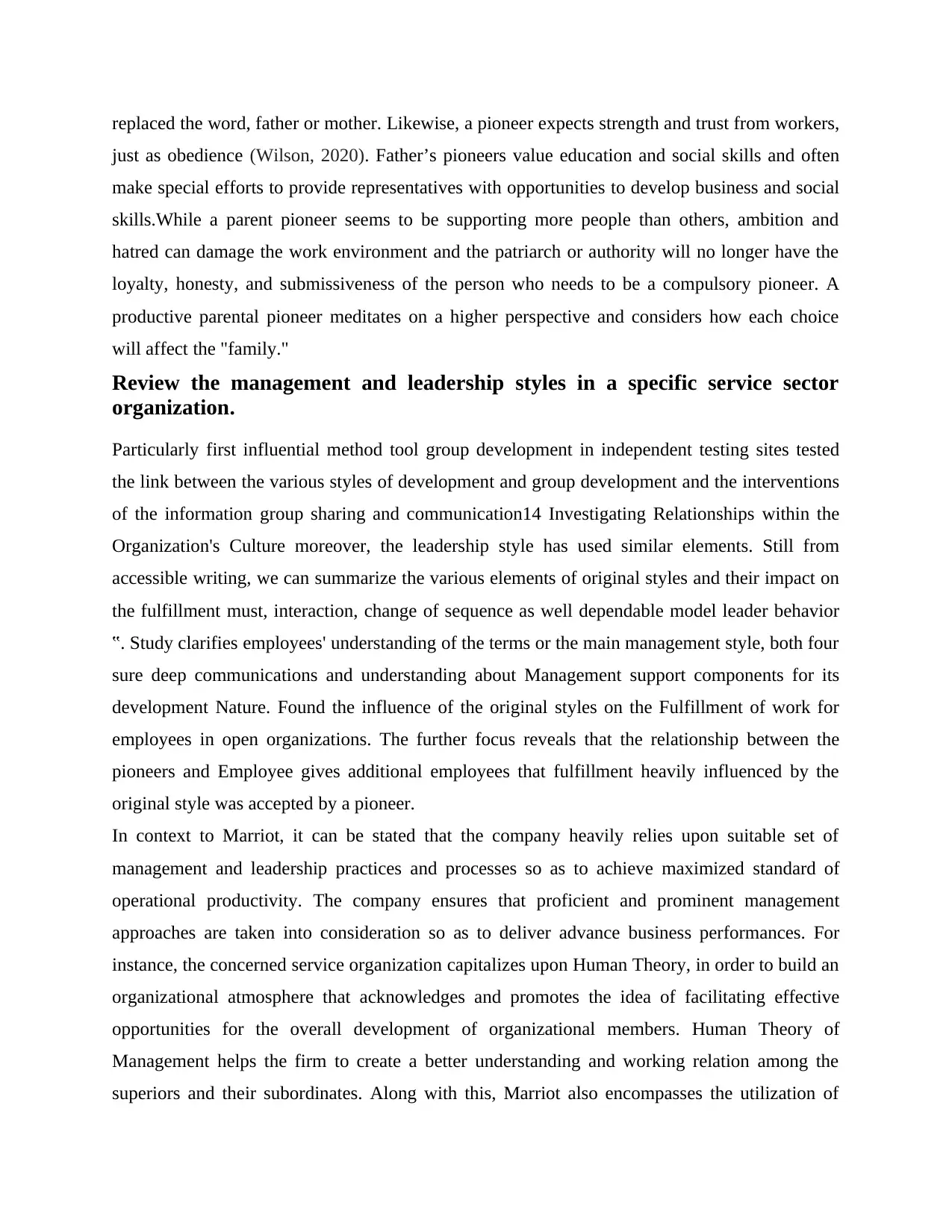
replaced the word, father or mother. Likewise, a pioneer expects strength and trust from workers,
just as obedience (Wilson, 2020). Father’s pioneers value education and social skills and often
make special efforts to provide representatives with opportunities to develop business and social
skills.While a parent pioneer seems to be supporting more people than others, ambition and
hatred can damage the work environment and the patriarch or authority will no longer have the
loyalty, honesty, and submissiveness of the person who needs to be a compulsory pioneer. A
productive parental pioneer meditates on a higher perspective and considers how each choice
will affect the "family."
Review the management and leadership styles in a specific service sector
organization.
Particularly first influential method tool group development in independent testing sites tested
the link between the various styles of development and group development and the interventions
of the information group sharing and communication14 Investigating Relationships within the
Organization's Culture moreover, the leadership style has used similar elements. Still from
accessible writing, we can summarize the various elements of original styles and their impact on
the fulfillment must, interaction, change of sequence as well dependable model leader behavior
‟. Study clarifies employees' understanding of the terms or the main management style, both four
sure deep communications and understanding about Management support components for its
development Nature. Found the influence of the original styles on the Fulfillment of work for
employees in open organizations. The further focus reveals that the relationship between the
pioneers and Employee gives additional employees that fulfillment heavily influenced by the
original style was accepted by a pioneer.
In context to Marriot, it can be stated that the company heavily relies upon suitable set of
management and leadership practices and processes so as to achieve maximized standard of
operational productivity. The company ensures that proficient and prominent management
approaches are taken into consideration so as to deliver advance business performances. For
instance, the concerned service organization capitalizes upon Human Theory, in order to build an
organizational atmosphere that acknowledges and promotes the idea of facilitating effective
opportunities for the overall development of organizational members. Human Theory of
Management helps the firm to create a better understanding and working relation among the
superiors and their subordinates. Along with this, Marriot also encompasses the utilization of
just as obedience (Wilson, 2020). Father’s pioneers value education and social skills and often
make special efforts to provide representatives with opportunities to develop business and social
skills.While a parent pioneer seems to be supporting more people than others, ambition and
hatred can damage the work environment and the patriarch or authority will no longer have the
loyalty, honesty, and submissiveness of the person who needs to be a compulsory pioneer. A
productive parental pioneer meditates on a higher perspective and considers how each choice
will affect the "family."
Review the management and leadership styles in a specific service sector
organization.
Particularly first influential method tool group development in independent testing sites tested
the link between the various styles of development and group development and the interventions
of the information group sharing and communication14 Investigating Relationships within the
Organization's Culture moreover, the leadership style has used similar elements. Still from
accessible writing, we can summarize the various elements of original styles and their impact on
the fulfillment must, interaction, change of sequence as well dependable model leader behavior
‟. Study clarifies employees' understanding of the terms or the main management style, both four
sure deep communications and understanding about Management support components for its
development Nature. Found the influence of the original styles on the Fulfillment of work for
employees in open organizations. The further focus reveals that the relationship between the
pioneers and Employee gives additional employees that fulfillment heavily influenced by the
original style was accepted by a pioneer.
In context to Marriot, it can be stated that the company heavily relies upon suitable set of
management and leadership practices and processes so as to achieve maximized standard of
operational productivity. The company ensures that proficient and prominent management
approaches are taken into consideration so as to deliver advance business performances. For
instance, the concerned service organization capitalizes upon Human Theory, in order to build an
organizational atmosphere that acknowledges and promotes the idea of facilitating effective
opportunities for the overall development of organizational members. Human Theory of
Management helps the firm to create a better understanding and working relation among the
superiors and their subordinates. Along with this, Marriot also encompasses the utilization of
⊘ This is a preview!⊘
Do you want full access?
Subscribe today to unlock all pages.

Trusted by 1+ million students worldwide
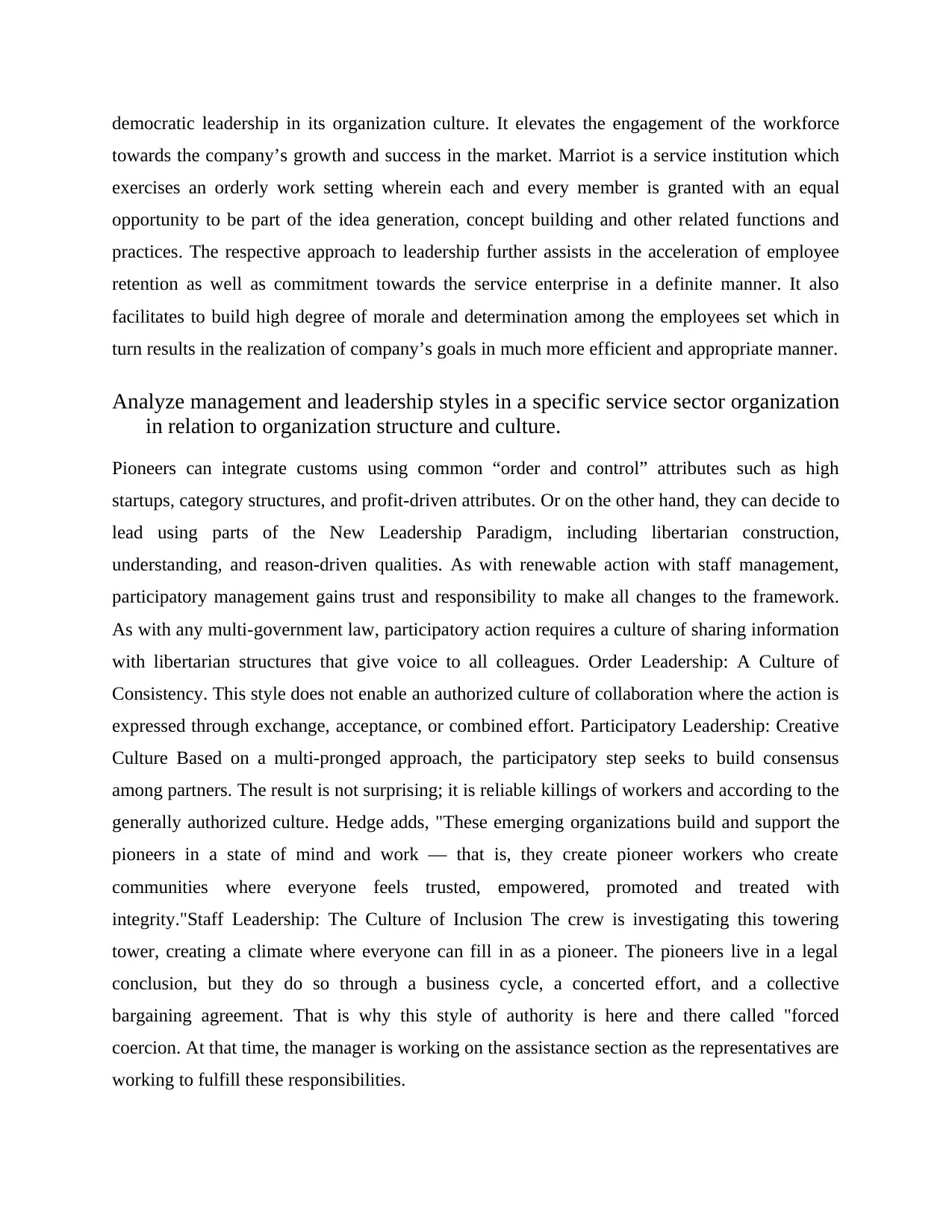
democratic leadership in its organization culture. It elevates the engagement of the workforce
towards the company’s growth and success in the market. Marriot is a service institution which
exercises an orderly work setting wherein each and every member is granted with an equal
opportunity to be part of the idea generation, concept building and other related functions and
practices. The respective approach to leadership further assists in the acceleration of employee
retention as well as commitment towards the service enterprise in a definite manner. It also
facilitates to build high degree of morale and determination among the employees set which in
turn results in the realization of company’s goals in much more efficient and appropriate manner.
Analyze management and leadership styles in a specific service sector organization
in relation to organization structure and culture.
Pioneers can integrate customs using common “order and control” attributes such as high
startups, category structures, and profit-driven attributes. Or on the other hand, they can decide to
lead using parts of the New Leadership Paradigm, including libertarian construction,
understanding, and reason-driven qualities. As with renewable action with staff management,
participatory management gains trust and responsibility to make all changes to the framework.
As with any multi-government law, participatory action requires a culture of sharing information
with libertarian structures that give voice to all colleagues. Order Leadership: A Culture of
Consistency. This style does not enable an authorized culture of collaboration where the action is
expressed through exchange, acceptance, or combined effort. Participatory Leadership: Creative
Culture Based on a multi-pronged approach, the participatory step seeks to build consensus
among partners. The result is not surprising; it is reliable killings of workers and according to the
generally authorized culture. Hedge adds, "These emerging organizations build and support the
pioneers in a state of mind and work — that is, they create pioneer workers who create
communities where everyone feels trusted, empowered, promoted and treated with
integrity."Staff Leadership: The Culture of Inclusion The crew is investigating this towering
tower, creating a climate where everyone can fill in as a pioneer. The pioneers live in a legal
conclusion, but they do so through a business cycle, a concerted effort, and a collective
bargaining agreement. That is why this style of authority is here and there called "forced
coercion. At that time, the manager is working on the assistance section as the representatives are
working to fulfill these responsibilities.
towards the company’s growth and success in the market. Marriot is a service institution which
exercises an orderly work setting wherein each and every member is granted with an equal
opportunity to be part of the idea generation, concept building and other related functions and
practices. The respective approach to leadership further assists in the acceleration of employee
retention as well as commitment towards the service enterprise in a definite manner. It also
facilitates to build high degree of morale and determination among the employees set which in
turn results in the realization of company’s goals in much more efficient and appropriate manner.
Analyze management and leadership styles in a specific service sector organization
in relation to organization structure and culture.
Pioneers can integrate customs using common “order and control” attributes such as high
startups, category structures, and profit-driven attributes. Or on the other hand, they can decide to
lead using parts of the New Leadership Paradigm, including libertarian construction,
understanding, and reason-driven qualities. As with renewable action with staff management,
participatory management gains trust and responsibility to make all changes to the framework.
As with any multi-government law, participatory action requires a culture of sharing information
with libertarian structures that give voice to all colleagues. Order Leadership: A Culture of
Consistency. This style does not enable an authorized culture of collaboration where the action is
expressed through exchange, acceptance, or combined effort. Participatory Leadership: Creative
Culture Based on a multi-pronged approach, the participatory step seeks to build consensus
among partners. The result is not surprising; it is reliable killings of workers and according to the
generally authorized culture. Hedge adds, "These emerging organizations build and support the
pioneers in a state of mind and work — that is, they create pioneer workers who create
communities where everyone feels trusted, empowered, promoted and treated with
integrity."Staff Leadership: The Culture of Inclusion The crew is investigating this towering
tower, creating a climate where everyone can fill in as a pioneer. The pioneers live in a legal
conclusion, but they do so through a business cycle, a concerted effort, and a collective
bargaining agreement. That is why this style of authority is here and there called "forced
coercion. At that time, the manager is working on the assistance section as the representatives are
working to fulfill these responsibilities.
Paraphrase This Document
Need a fresh take? Get an instant paraphrase of this document with our AI Paraphraser
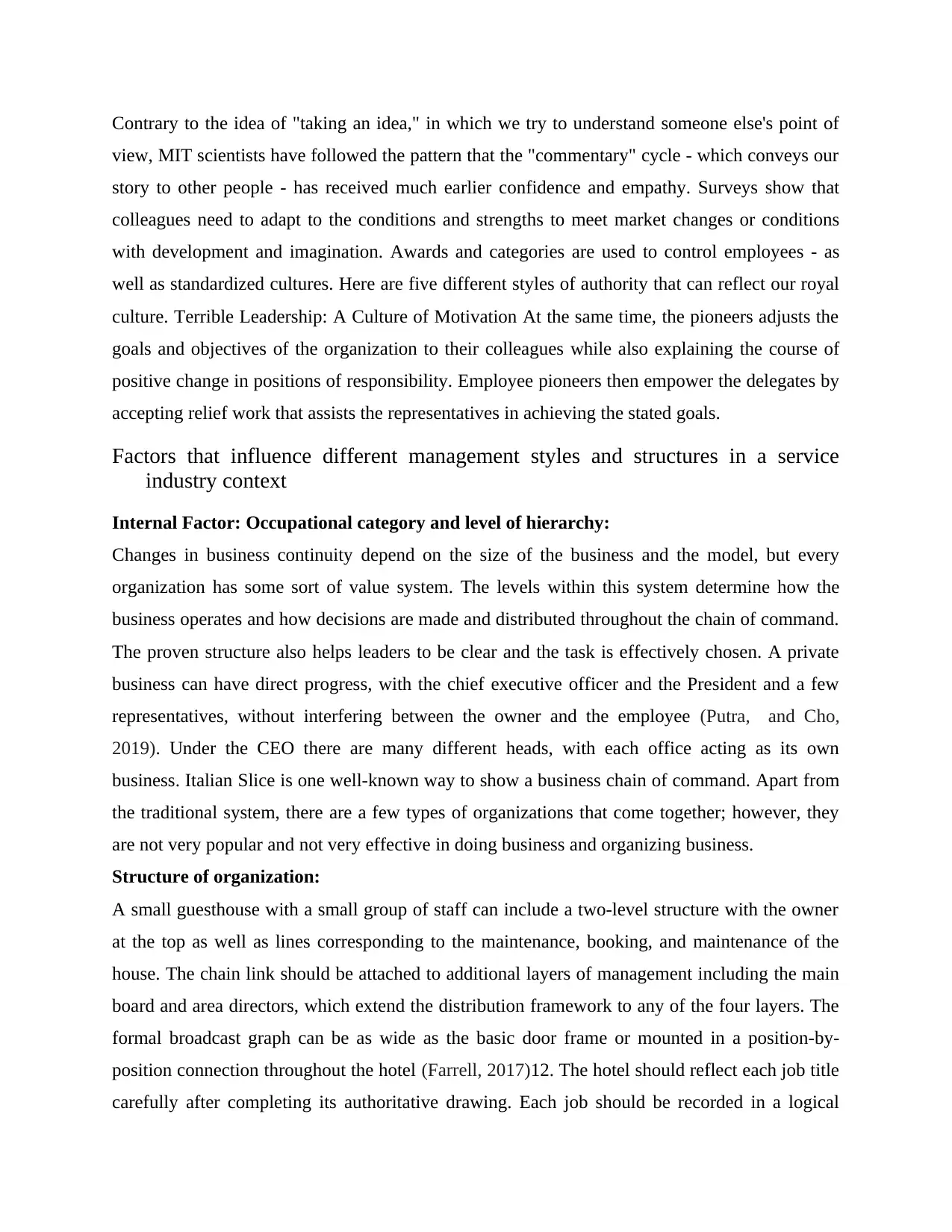
Contrary to the idea of "taking an idea," in which we try to understand someone else's point of
view, MIT scientists have followed the pattern that the "commentary" cycle - which conveys our
story to other people - has received much earlier confidence and empathy. Surveys show that
colleagues need to adapt to the conditions and strengths to meet market changes or conditions
with development and imagination. Awards and categories are used to control employees - as
well as standardized cultures. Here are five different styles of authority that can reflect our royal
culture. Terrible Leadership: A Culture of Motivation At the same time, the pioneers adjusts the
goals and objectives of the organization to their colleagues while also explaining the course of
positive change in positions of responsibility. Employee pioneers then empower the delegates by
accepting relief work that assists the representatives in achieving the stated goals.
Factors that influence different management styles and structures in a service
industry context
Internal Factor: Occupational category and level of hierarchy:
Changes in business continuity depend on the size of the business and the model, but every
organization has some sort of value system. The levels within this system determine how the
business operates and how decisions are made and distributed throughout the chain of command.
The proven structure also helps leaders to be clear and the task is effectively chosen. A private
business can have direct progress, with the chief executive officer and the President and a few
representatives, without interfering between the owner and the employee (Putra, and Cho,
2019). Under the CEO there are many different heads, with each office acting as its own
business. Italian Slice is one well-known way to show a business chain of command. Apart from
the traditional system, there are a few types of organizations that come together; however, they
are not very popular and not very effective in doing business and organizing business.
Structure of organization:
A small guesthouse with a small group of staff can include a two-level structure with the owner
at the top as well as lines corresponding to the maintenance, booking, and maintenance of the
house. The chain link should be attached to additional layers of management including the main
board and area directors, which extend the distribution framework to any of the four layers. The
formal broadcast graph can be as wide as the basic door frame or mounted in a position-by-
position connection throughout the hotel (Farrell, 2017)12. The hotel should reflect each job title
carefully after completing its authoritative drawing. Each job should be recorded in a logical
view, MIT scientists have followed the pattern that the "commentary" cycle - which conveys our
story to other people - has received much earlier confidence and empathy. Surveys show that
colleagues need to adapt to the conditions and strengths to meet market changes or conditions
with development and imagination. Awards and categories are used to control employees - as
well as standardized cultures. Here are five different styles of authority that can reflect our royal
culture. Terrible Leadership: A Culture of Motivation At the same time, the pioneers adjusts the
goals and objectives of the organization to their colleagues while also explaining the course of
positive change in positions of responsibility. Employee pioneers then empower the delegates by
accepting relief work that assists the representatives in achieving the stated goals.
Factors that influence different management styles and structures in a service
industry context
Internal Factor: Occupational category and level of hierarchy:
Changes in business continuity depend on the size of the business and the model, but every
organization has some sort of value system. The levels within this system determine how the
business operates and how decisions are made and distributed throughout the chain of command.
The proven structure also helps leaders to be clear and the task is effectively chosen. A private
business can have direct progress, with the chief executive officer and the President and a few
representatives, without interfering between the owner and the employee (Putra, and Cho,
2019). Under the CEO there are many different heads, with each office acting as its own
business. Italian Slice is one well-known way to show a business chain of command. Apart from
the traditional system, there are a few types of organizations that come together; however, they
are not very popular and not very effective in doing business and organizing business.
Structure of organization:
A small guesthouse with a small group of staff can include a two-level structure with the owner
at the top as well as lines corresponding to the maintenance, booking, and maintenance of the
house. The chain link should be attached to additional layers of management including the main
board and area directors, which extend the distribution framework to any of the four layers. The
formal broadcast graph can be as wide as the basic door frame or mounted in a position-by-
position connection throughout the hotel (Farrell, 2017)12. The hotel should reflect each job title
carefully after completing its authoritative drawing. Each job should be recorded in a logical
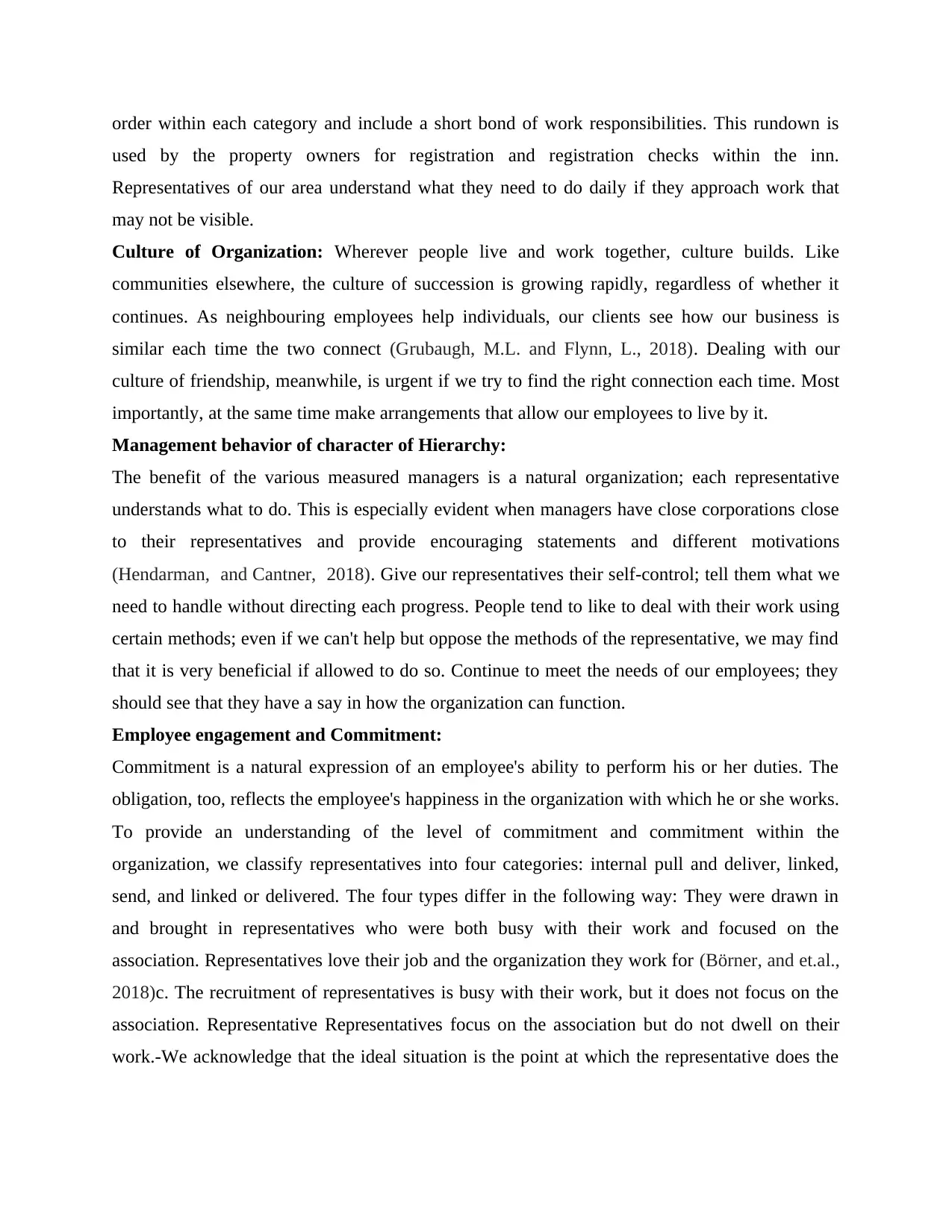
order within each category and include a short bond of work responsibilities. This rundown is
used by the property owners for registration and registration checks within the inn.
Representatives of our area understand what they need to do daily if they approach work that
may not be visible.
Culture of Organization: Wherever people live and work together, culture builds. Like
communities elsewhere, the culture of succession is growing rapidly, regardless of whether it
continues. As neighbouring employees help individuals, our clients see how our business is
similar each time the two connect (Grubaugh, M.L. and Flynn, L., 2018). Dealing with our
culture of friendship, meanwhile, is urgent if we try to find the right connection each time. Most
importantly, at the same time make arrangements that allow our employees to live by it.
Management behavior of character of Hierarchy:
The benefit of the various measured managers is a natural organization; each representative
understands what to do. This is especially evident when managers have close corporations close
to their representatives and provide encouraging statements and different motivations
(Hendarman, and Cantner, 2018). Give our representatives their self-control; tell them what we
need to handle without directing each progress. People tend to like to deal with their work using
certain methods; even if we can't help but oppose the methods of the representative, we may find
that it is very beneficial if allowed to do so. Continue to meet the needs of our employees; they
should see that they have a say in how the organization can function.
Employee engagement and Commitment:
Commitment is a natural expression of an employee's ability to perform his or her duties. The
obligation, too, reflects the employee's happiness in the organization with which he or she works.
To provide an understanding of the level of commitment and commitment within the
organization, we classify representatives into four categories: internal pull and deliver, linked,
send, and linked or delivered. The four types differ in the following way: They were drawn in
and brought in representatives who were both busy with their work and focused on the
association. Representatives love their job and the organization they work for (Börner, and et.al.,
2018)c. The recruitment of representatives is busy with their work, but it does not focus on the
association. Representative Representatives focus on the association but do not dwell on their
work.-We acknowledge that the ideal situation is the point at which the representative does the
used by the property owners for registration and registration checks within the inn.
Representatives of our area understand what they need to do daily if they approach work that
may not be visible.
Culture of Organization: Wherever people live and work together, culture builds. Like
communities elsewhere, the culture of succession is growing rapidly, regardless of whether it
continues. As neighbouring employees help individuals, our clients see how our business is
similar each time the two connect (Grubaugh, M.L. and Flynn, L., 2018). Dealing with our
culture of friendship, meanwhile, is urgent if we try to find the right connection each time. Most
importantly, at the same time make arrangements that allow our employees to live by it.
Management behavior of character of Hierarchy:
The benefit of the various measured managers is a natural organization; each representative
understands what to do. This is especially evident when managers have close corporations close
to their representatives and provide encouraging statements and different motivations
(Hendarman, and Cantner, 2018). Give our representatives their self-control; tell them what we
need to handle without directing each progress. People tend to like to deal with their work using
certain methods; even if we can't help but oppose the methods of the representative, we may find
that it is very beneficial if allowed to do so. Continue to meet the needs of our employees; they
should see that they have a say in how the organization can function.
Employee engagement and Commitment:
Commitment is a natural expression of an employee's ability to perform his or her duties. The
obligation, too, reflects the employee's happiness in the organization with which he or she works.
To provide an understanding of the level of commitment and commitment within the
organization, we classify representatives into four categories: internal pull and deliver, linked,
send, and linked or delivered. The four types differ in the following way: They were drawn in
and brought in representatives who were both busy with their work and focused on the
association. Representatives love their job and the organization they work for (Börner, and et.al.,
2018)c. The recruitment of representatives is busy with their work, but it does not focus on the
association. Representative Representatives focus on the association but do not dwell on their
work.-We acknowledge that the ideal situation is the point at which the representative does the
⊘ This is a preview!⊘
Do you want full access?
Subscribe today to unlock all pages.

Trusted by 1+ million students worldwide
1 out of 26
Related Documents
Your All-in-One AI-Powered Toolkit for Academic Success.
+13062052269
info@desklib.com
Available 24*7 on WhatsApp / Email
![[object Object]](/_next/static/media/star-bottom.7253800d.svg)
Unlock your academic potential
Copyright © 2020–2025 A2Z Services. All Rights Reserved. Developed and managed by ZUCOL.




